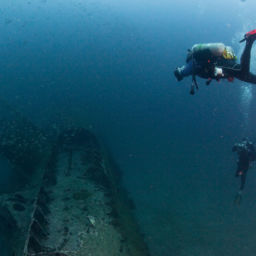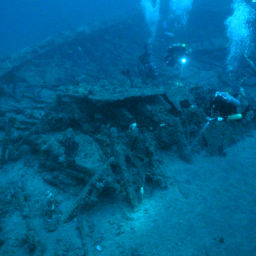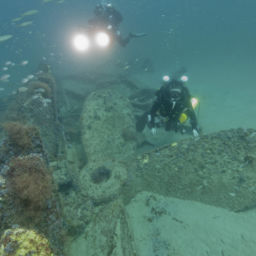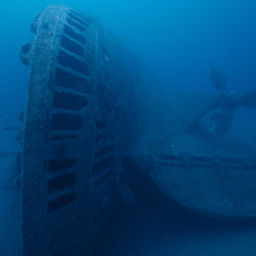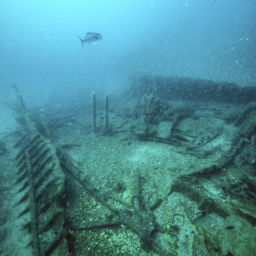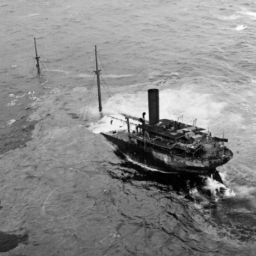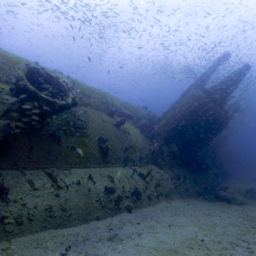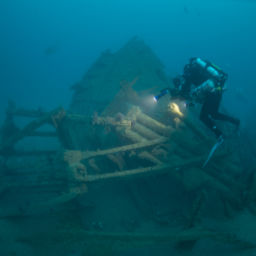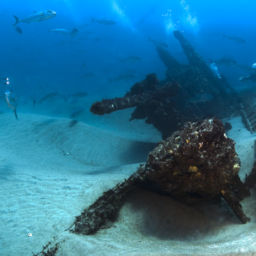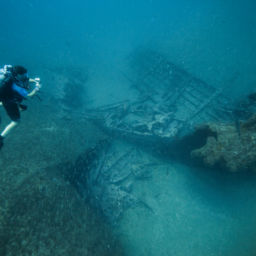From January to the end of August 1942, German U-boats attacked more than 285 vessels in North American waters. Just off coastal North Carolina, the remnants of many of these ships are scattered on the ocean floor. The remains of this little-known battlefield serve as the final resting place for 90 ships and nearly 1,700 men lost during the Battle of the Atlantic. . Over the course of the Battle of the Atlantic, eight Allied convoy vessels, 78 merchant freighters, and tankers, and four German U-boats sank off North Carolina’s coast. Each shipwreck tells a unique story; today we visit the Caribsea.
The Caribsea sinks
In the eerie darkness of night, shortly after 2:00 am on March 11, 1942, the Caribsea’s second mate Hugh Spencer thought he saw a ship in the distance. As the captain peered through the bridge window, the glass suddenly shattered as a torpedo struck the ship. The Caribsea, a merchant ship loaded with 3,600 tons of manganese ore, was traveling north to Norfolk, Virginia. As it approached Cape Lookout, North Carolina, it slowed down to pass Diamond Shoals. About that time, U-158, patrolling in the area, spotted the slow-moving ship and fired one torpedo.
As the vessel began to sink, seawater flooded the foredeck and the alarm sounded to abandon ship. The Caribsea sank in just two minutes. This left no time to launch lifeboats or for the men to do anything other than jump into the ocean. As they dove into the cold water, the men clung to the oily wreckage. Minutes later, U-158 surfaced just 500 feet away and circled the area for hours but offered no assistance to the survivors. Finally, after about 10 hours, the steamship Norlandia found and rescued the seven survivors left of the 28-member crew.
Three days after it sank, an Outer Banks resident, Chris Gaskill, was walking along the beach of Ocracoke Island and found a frame with a certificate floating in the surf. He was surprised to find that it belonged to his cousin, Jim Gaskill, a third mate on the Caribsea. The next day, an out-of-town guest staying at the Gaskill’s inn came across a floating piece of wreckage with the name Caribsea etched on the side. Both items confirmed the Caribsea’s fate. Further, both offered a stark reminder as to just how close the war was to the United States.
Lethal attacks by the U-158 claimed the lives of 187 Allied merchant sailors, including those of the Caribsea. Disturbed by the bloodshed in the waters surrounding their homes, the people of the Outer Banks soon felt their grief turn into hatred for the German U-boats. When they heard that U.S. aircraft had dropped depth charges, sinking the U-158 in the North Atlantic, the people of the Outer Banks celebrated.
Diving the Caribsea
Resting in 85 feet (26 m) of water, 15 miles (24 km) northeast of Cape Lookout, the Caribsea is a popular recreational dive site. The wreck lies near the western margin of the Gulf Stream, which creates a favorable environment for abundant marine life. Spadefish, baitfish, amberjacks, stingrays, cobia, Spanish mackerel, sand-tiger sharks, and loggerhead turtles are just a few of the frequent guest on the Caribsea. Other highlights are the beautiful corals, sponges, and other colorful benthic organisms.
Although the site is known for its high and variable currents, visibility averages about 60 to 80 feet (18 to 24 m) year-round. As divers descend, the wreck comes into view, resting upon its keel on a flat, sandy plain. The ship measures 230 feet long (70 m) by 60 feet (18 m) wide, is contiguous and mostly intact. Some areas of the wreck site feature 20 feet (6 m) of vertical relief. The site’s main features are the bow and stern sections, and divers can recognize the shape of the hull with parts rising up 15 feet (5 m) from the seafloor. Other major features include the triple-expansion engine and two Scotch boilers, both located amidships. Look also for the anchor windlass, hatch beams, stem posts, and frames.
“The site offers great recreational diving for all skill levels,” says Tane Casserley, Monitor National Marine Sanctuary’s research coordinator and maritime archaeologist. “Most of the time, the site has good visibility and divers have the opportunity to see an abundance of marine life.”
As divers explore the Caribsea, they see a ship representative of the 78 merchant ships lost during World War II’s Battle of the Atlantic. Consequently, they will feel what it was like in 1942 off of coastal North Carolina, where the war truly came home to America. Learn more about the Caribsea here.
An Expanded Sanctuary
In an effort to honor the service and sacrifice of those lost during the Battle of the Atlantic, NOAA in 2019 will release a draft proposal to expand the boundaries of Monitor National Marine Sanctuary to include a nationally significant collection of shipwrecks that currently have little or no legal protection. The expansion would also establish the largest area designated as a World War II battlefield anywhere in the world.
To learn more about the proposal, click here.
By Shannon Ricles, Monitor National Marine Sanctuary












